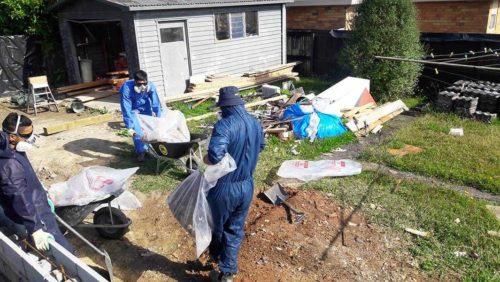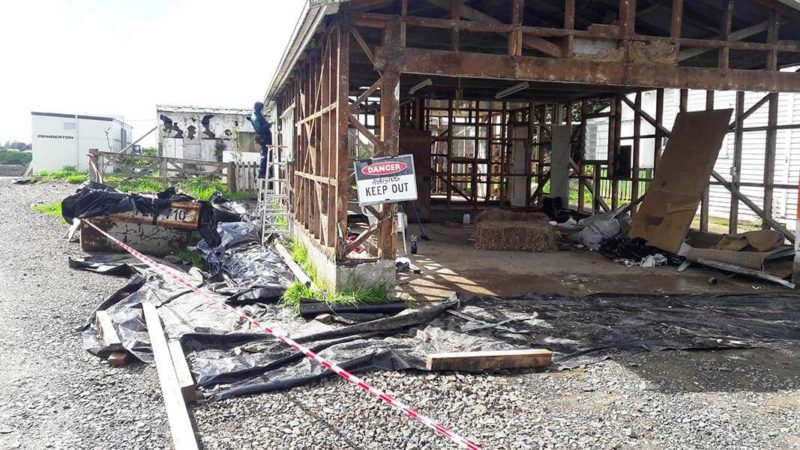Asbestos Removals:Understanding Asbestos Cladding: Risks and Considerations for Builders

Asbestos-related disease is the number one killer in New Zealand workplaces.
Despite increased awareness of its dangers, more than 170 New Zealanders die each year (on average) from diseases stemming from exposure to asbestos. The time between exposure to asbestos and development of disease can be decades long.
The hazard presented by asbestos is its fibres which, if inhaled, can lodge in the lungs.
What to do if you uncover or damage materials that may contain asbestos
- Stop the work immediately.
- Keep people away.
- Minimise the spread of contamination to other areas.
- Get advice on what to do next.
Removing asbestos
From 4 April 2016, if more than 10 m2 of non-friable asbestos has to be removed over the whole course of the project for the site, it must be done by a licensed asbestos removalist.
All friable asbestos removal work (where the number of fibres released is likely to be high) must also be carried out by a licensed asbestos removalist. This includes work on asbestos lagging, asbestos insulation and damaged asbestos board.
A licensed asbestos removalist can be a person holding a current Certificate of Competence until April 2018.
Working with asbestos
Simple ways to protect yourself.
It’s really important that you take precautions to protect yourself against asbestos, even on small jobs that don’t seem to create much dust.
Remember
If possible, plan the job to avoid disturbing any asbestos.
If the asbestos has to be disturbed, don’t start work until you have
double-checked how to do it safely and that you have the right
information and training.
Three simple things will help keep you safe
Three simple things will help keep you safe when doing asbestos work:
- Keep dust down.
- Use the right protective equipment.
- Clean up properly.
Keep dust down
- Keep ACM damp, but not too wet.
- Before you start a job, and if it is safe to do so, wet materials using a low-pressure water spray such as a garden sprayer or a hand-held water spray. Continue wetting the ACM as you work. This will reduce the amount of dust.
- Use thickened substances, pastes and gels, such as wallpaper paste, hair gel or shaving cream to cover the surfaces of the ACM being worked on.
- A mixture of eight parts water to one part washing-up liquid will help the water soak into the material. OR
- Do not use a hose as this can be high-pressure and will spread the dust around.
- Only use power tools set at the lowest speed so you do not create a lot of dust. Use dust collection equipment wherever possible.
- Use plastic sheets to cover your work area to help stop the spread of dust. They will also make cleaning up easier.
Use the right protective equipment
Wear a mask
- Not all masks protect from asbestos.
- A disposable P2 mask with a valve is the minimum needed for this work. P1 or ‘nuisance dust’ masks will not provide the protection you need.
- Don’t re-use disposable masks.
- Make sure your mask fits properly. Facial hair and stubble make it almost impossible to get a good seal between your face and the mask.
Wear overalls
- Disposable overalls will stop the tiny asbestos fibres getting on your clothes.
- Don’t re-use disposable overalls.
- Wear the overalls one size too big as it will help prevent ripping at the seams.
- Make sure you put the legs of the overalls over the top of your footwear – don’t tuck them in as it lets in dust.
Clean up properly
It’s really important to clean up properly so that you safely remove and dispose of the asbestos waste.
The work area and tools
- Clean up as you go to stop waste building up.
- Use a damp cloth to wipe down tools and surfaces to remove asbestos fibres. Do not re-use the cloth. It must be disposed of as asbestos waste.
- Don’t sweep up because this will spread asbestos fibres into the air.
- Don’t use domestic vacuum cleaners to clean up asbestos dust. Use a vacuum with a type of filter designed to capture fine particles like asbestos.
Personal clean-up
- Dispose of disposable masks and overalls safely after you have finished the job. The mask and overalls are asbestos waste.
- Don’t take overalls home or wear them in vehicles. This will prevent people at home being exposed to asbestos fibres.
Disposal
- Make sure all waste, including masks, overalls, cloths and plastic sheets are double-bagged in heavy-duty plastic bags, sealed with tape and marked as asbestos waste.
- Dispose of the asbestos waste at an authorised disposal site. Contact the local tips in your area to find one that accepts asbestos waste.
Asbestos cladding removal is a critical aspect of construction and renovation projects in Auckland, New Zealand. Builders must prioritize safety and ensure proper removal practices to protect themselves, their clients, and the environment. Here's everything builders need to know about safely removing asbestos cladding.
Understanding Asbestos Cladding: Risks and Considerations for Builders
- Asbestos cladding was commonly used in construction until the late 1980s for its fire resistance and durability.
- Builders working on older properties in Auckland must be aware of the presence of asbestos cladding, which poses serious health risks if disturbed.
- It's crucial for builders to identify asbestos-containing materials and follow safe removal procedures to mitigate exposure risks.
Health Risks of Asbestos Exposure: Importance of Safe Removal Practices
- Inhalation of asbestos fibers can lead to severe respiratory diseases such as asbestosis, lung cancer, and mesothelioma.
- Builders and construction workers are at risk of asbestos exposure during demolition, renovation, and construction activities involving asbestos-containing materials.
- Adhering to safe removal practices is essential to minimize the risk of asbestos exposure and protect the health of workers and occupants.
Safe Asbestos Cladding Removal Process: Steps for Builders to Follow
- Assessment: Conduct a thorough inspection to identify asbestos-containing cladding in the building.
- Risk Management: Develop a risk management plan outlining safe removal procedures, including containment measures and personal protective equipment (PPE).
- Engage Professionals: Consider partnering with experienced asbestos removal companies like Safety 1st Projects Ltd. for safe and compliant removal.
- Containment: Seal off the work area to prevent the spread of asbestos fibers and minimize exposure to workers and nearby occupants.
- Personal Protective Equipment (PPE): Ensure all workers wear appropriate PPE, including respirators, gloves, and coveralls, to minimize exposure.
- Wet Removal: Use wet removal techniques to suppress dust and minimize the release of asbestos fibers into the air.
- Disposal: Asbestos waste must be properly packaged and disposed of at authorized facilities following NZDAA guidelines.
Hiring Professionals for Asbestos Removal: Partnering with Safety 1st Projects Ltd.
- Safety 1st Projects Ltd. specializes in safe and efficient asbestos removal services in Auckland, providing builders with professional assistance and peace of mind.
- Their team of trained professionals follows strict safety protocols and complies with all regulations set forth by the NZDAA.
Compliance and Regulations: NZDAA Guidelines for Asbestos Removal in Auckland
- Builders must comply with regulations and guidelines set forth by the NZDAA for the safe removal and disposal of asbestos-containing materials.
- Adhering to these regulations is essential to ensure the safety of workers, clients, and the community.
Ensuring Safety on Construction Sites: Best Practices for Asbestos Management
- Implement strict asbestos management procedures on construction sites to prevent accidental exposure and ensure worker safety.
- Provide ongoing training and education for workers on asbestos awareness, handling, and safe removal practices.
Safeguarding Your Reputation: Importance of Proper Asbestos Disposal
- Proper disposal of asbestos waste is crucial to protect the environment and maintain a positive reputation as a responsible builder.
- Work with licensed waste disposal facilities that specialize in handling asbestos materials to ensure compliance and safety.
In conclusion, builders in Auckland must prioritize safety when dealing with asbestos cladding. By understanding the risks, following safe removal practices, and partnering with professionals like Safety 1st Projects Ltd., builders can ensure the safety of their workers and clients while maintaining compliance with regulations.
For expert assistance in asbestos removal, visit Safety 1st Removals at www.safety1stremovals.co.nz, and learn more about asbestos removal regulations at www.nzdaa.co.nz.
Make Enquiry